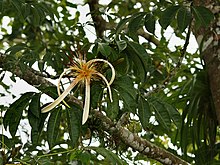Pachira
| Pachira | |
|---|---|

| |
| Pachira aquatica | |
| Scientific classification | |
| Kingdom: | Plantae |
| Clade: | Tracheophytes |
| Clade: | Angiosperms |
| Clade: | Eudicots |
| Clade: | Rosids |
| Order: | Malvales |
| Family: | Malvaceae |
| Subfamily: | Bombacoideae |
| Genus: | Pachira Aubl.[1] |
| Species | |
|
See text | |
| Synonyms[1] | |
|
Bombacopsis Pittier | |
Pachira is a genus of tropical trees distributed in Central and South America, Africa and India. They are classified in the subfamily Bombacoideae of the family Malvaceae. Previously the genus was assigned to Bombacaceae. [2][1] Prior to that the genus was found in the (now obsolete) Sterculiaceae.
Some 77 species have been identified.[3][4][5] They form small or large trees with digitate leaves, and the fruit an oval woody one-celled capsule opening by a number of divisions and containing many seeds. The genus name is derived from a language spoken in Guyana.[6]
History
Although first named Pachira by Jean Baptiste Aublet in 1775, Carl Linnaeus the Younger unaware of this separately is said to have called the genus Carolinea after Princess (or Marchioness) "Sophia Caroline of Baden" in 1782. [7] [8] [9] [10] The principle of precedence gives the authority to Pachira.
The Margrave of Baden, Karl Wilhelm (1709 – 1738) founded the Karlsruhe Palace (Karlsruher Schloß) in 1715. He had a considerable interest in Botany, particularly the exotic, and had large numbers of trees imported for the Palace Gardens (Schloßgarten). He was succeeded by his Grandson, Karl Friedrich (1738 - 1811) who married Princess Karoline Luise von Hessen-Darmstadt (1723 - 1783) in 1751. Karoline Luise was a noted botanist. She corresponded with Carl von Linné (Linnaeus), cultivated numerous plants in the palace gardens, had engravings of them made for a book and had them all classified according to Linnaeus' system. Linnaeus' son, Carl Linnaeus the younger, recognised her contributions by naming one of the trees, Pachira aquatica (German: Glückskastanie) Carolinea princeps after her. [11]
Commercial use
Timber, cordage and seeds for stuffing pillows and cushions. [12]
Selected species
- Pachira aquatica Aubl. (syn. P. macrocarpa)
- Pachira emarginata A. Rich.
- Pachira glabra Pasq.
- Pachira insignis (Sw.) Savigny
- Pachira orinocensis (A.Robyns) W.S.Alverson
- Pachira quinata (Jacq.) W.S.Alverson[13]
Formerly placed here
- Pseudobombax grandiflorum (Cav.) A.Robyns (as P. cyathophora Casar.)[13]
References
- ^ a b c "Genus: Pachira Aubl". Germplasm Resources Information Network. United States Department of Agriculture. 2003-06-05. Archived from the original on 2012-10-10. Retrieved 2013-04-29.
- ^ IABIN Archived 2012-07-01 at archive.today
- ^ Plant systematics: Pachira
- ^ Botanica: Pachira
- ^ Royal Botanical gardens Kew: Pachira insignis
- ^ Helmut Genaust (1983): Etymologisches Wörterbuch der botanischen Pflanzennamen, 2. Auflage. Birkhäuser Verlag – ISBN 3-7643-1399-4
- ^ The Imperial Dictionary of the English Language, Ogilvie, J. (ed.) 1883 Pachira p. 351.
- ^ Loudon's Hortus britannicus: A catalogue of all the plants indigenous, cultivated in, or introduced to Britain. London, 1830. I: 292
- ^ Loudon JC. An encyclopædia of plants. Longman London 1836, p. 592
- ^ Lindley and Moore. The treasury of botany, Longmans, London 1866. Pachira p. 833
- ^ Karlsruhe Institute of Technology: Early Developments of Botany and Genetics in Karlsruhe 1715 - 1832
- ^ Brande and Cox (eds.) A dictionary of science, literature, & art. Longmans, London 1866 Pachira II: 761
- ^ a b "GRIN Species Records of Pachira". Germplasm Resources Information Network. United States Department of Agriculture. Archived from the original on 2012-07-18. Retrieved 2013-04-29.
Further reading
 Media related to Pachira at Wikimedia Commons
Media related to Pachira at Wikimedia Commons Data related to Pachira at Wikispecies
Data related to Pachira at Wikispecies- New Species and Combinations of Catostemma and Pachira (Bombacaceae) from the Venezuelan Guayana. William S. Alverson. Novon Vol. 4, No. 1 (Spring, 1994), pp. 3-8
- Don G. A general system of gardening and botany: containing a complete enumeration and description of all plants hitherto known with their generic and specific characters, places of growth, time of flowering, mode of culture and their uses in medicine and domestic economy : preceded by introductions to the linnaean and natural systems and a glossary of the terms used ; founded upon Miller's Gardener's dictionary and arranged according to the natural system ; in four volumes. London 1831. Carolinea I: 510
